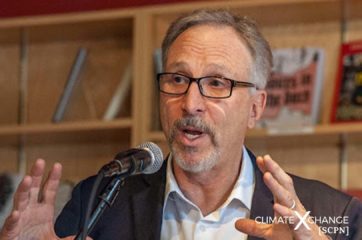All across the country, members of our State Climate Policy Network (SCPN) are fighting to make an impact on climate change in their communities. We have individuals in our Network from all 50 states, each experiencing climate change differently in their local areas and finding unique solutions to build resiliency efforts.
Jeff Peterson is a former senior policy advisor at the United States Environmental Protection Agency (EPA) and the author of A New Coast: Strategies for Responding to Devastating Storms and Rising Seas. He has recently been working with the Coastal Floods Resilience Project and Rising Seas Institute to identify and advocate for sustainable policy solutions to the risks of rising sea levels and intense storms.
This interview has been edited for brevity and clarity.
Izzy Hamilton: Can you tell me a little bit about your background in climate policy work and how you got started in this space?
Jeff Peterson: Climate change has occupied a major part of my work for the last 15 or 20 years. Fifteen years ago, while working at the Environmental Protection Agency, I led an effort to develop the first climate adaptation plan for the National Water Program. That involved sitting down with our clean water and drinking water program staff in the national program and our regional offices and working with states to look at the threats that climate change poses to achieving clean water and safe drinking water. As part of that work, we looked at the issues related to coastal communities and coastal infrastructure ranging from wastewater treatment plants to septic systems and drinking water systems. We found that there is a considerable threat from rising sea levels and more severe storms to those assets.
So, I was working in that area, and around that time I had the chance to work at the White House Council on Environmental Quality on water policy issues. As part of that work, I was addressing climate change in the water resources area and also looking at storm impacts and coastal issues related to sea-level rise. I ended up leaving the EPA in 2017 and retired, but I wanted to look harder at some of the issues related to sea-level rise. I wrote a book on climate impacts on the coast, focusing on more severe storms and sea-level rise, called A New Coast. As a result of that effort, for almost a year now, I’ve been working with a group of nonprofit organizations trying to identify strategies and policies that can be particularly effective for addressing the risks related to climate change as they occur in coastal communities.
Izzy Hamilton: On the topic of your book, A New Coast, I was curious if there was anyone impetus that led you to write that book and inspired you to take up that project?
Jeff Peterson: Well, yes. Before leaving the EPA, I had been co-chairing the EPA agency-wide sea level rise workgroup. I had been working with other agencies, NOAA (National Oceanic and Atmospheric Administration), the Army Corps of Engineers, and FEMA (Federal Emergency Management Agency) on issues related to sea-level rise. NOAA had developed their Sea Level Rise Scenarios Report, a 2017 publication that reflected a lot of input from different government agencies on the seriousness of sea-level rise for the American coastline. Often when you read about sea-level rise, you see numbers that are projected increases in global mean sea level rise. A lot of people don’t realize that in addition to that global mean number you have to account for regional variation. Along the American coast, the regional variation is almost always above the global average.
In some cases, like along the Mid-Atlantic, those global mean averages can be increased as much as 20 or 30 percent to account for local variation. One example of local variation is land subsidence, which is a particular issue along the Atlantic coast, but also in other areas along the Gulf of Mexico. Other factors contribute to that, including ocean currents. But it’s important to realize that there’s a lot of regional variation and, in that 2017 report, they honed in on the more localized impacts of sea-level rise along the coast. To me, that was a real warning bell that the American coast was particularly vulnerable, and that it was imperative to start planning now for the projected future sea-level rise. That gave me the determination to try and layout a foundation of good policies at the national level but also at state and local levels to be prepared for risks that severe storms will bring in the not too distant future.
Izzy Hamilton: Since you left [the EPA], you’ve been involved in the Coastal Floods Resilience Project and the Rising Seas Institute. Can you speak briefly on the missions of those two organizations, and what kind of work they’re doing?
Jeff Peterson: When I was putting together my book, A New Coast, I included at the end some ideas that I thought would be good steps to be better prepared for these issues. But, the ideas need to be advocated for. I didn’t want the book to say, ‘well, here are my two cents on what should be done.’ I wanted to try and think about what would get these policies further toward being implemented effectively. One of the things I had suggested is that the range of nonprofit organizations that are interested in climate adaptation issues, and particularly coastal resilience issues, would do well to coordinate their efforts and work together to both identify common processes that they felt the federal government should take on, and then to nudge and prod different parts of the federal government to move in that direction. For almost a year now, I’ve been facilitating some cooperative engagement with some of the nonprofit organizations that are working in this area. We have developed a policy agenda that includes a whole range of things that we collectively agree are important for the federal government to do. And we’ve developed eight specific white papers that go into more detail about what the federal government or Congress might do in a particular area. Anything ranging from infrastructure to the National Flood Insurance Program, to how the Securities and Exchange Commission might better address disclosure of corporate risks related to coastal flooding and sea-level rise. We’re going to continue that work through collaborating and articulating in detail what can be done in those areas. That’s the Coastal Flood Resilience Project.
On the topic of the Rising Seas Institute, that’s a new effort led by John Englander, who has been very active in the area of sea-level rise, science, risks, and response actions for many years. He’s published several books and has a new book out looking at this issue. Some of the leaders in the scientific community, and others interested in this area, have been organizing ideas looking at the threats that rising seas pose, not just to the United States, but around the world. The goal is to better understand the science that goes into evaluating and projecting future risks, and advancing general ideas, programs, and policies that different countries around the world might consider and adopt to be better prepared for those risks.
Izzy Hamilton: Using that data in those projections, what, in your opinion, should be the state’s top policy priorities?
Jeff Peterson: Well, let me say right off, I think the state of Virginia is doing a very commendable job with focusing on the risk to coastal environments and recognizing the risk of storms and sea-level rise. I want to applaud the efforts of the Governor. He and the Virginia state agencies have done a lot of hard and valuable work on a really difficult problem. Identifying some priorities, sitting here today on the 12th of October, I would say the top priority is the Master Plan that is due to be released next month. It’s critical that this Governor and this administration get that done, and not leave it undone for a new administration. That would be number one.
And I guess that maybe number 1a is for the administration now to not just release the Master Plan, but do the legwork of getting local government support for the plan. Another priority I would recommend is that the state continue all of its great efforts, but it shouldn’t try and do this alone, or without substantial help from the federal government. I would encourage the state to be aggressive advocates with federal agencies and Congress for support from the federal government to implement the Master Plan and provide the necessary funding. I guess the final thing I’d say is that clearly, the state has recognized that disadvantaged communities are especially at risk of coastal flooding from storms but also from sea level rise and that they’re going to need extra help in figuring out how to prepare for those risks. And while I think that the state has made a strong effort in that area, I think it would be worth reviewing.
Izzy Hamilton: Speaking of states receiving federal support for climate resilience projects, there is currently a $1 trillion infrastructure bill making its way through Congress that is said to include funding to support sea-level rise resilience projects. Based on your experience working with the federal government, are you optimistic that this bill will be sufficient to start up the kind of broad coastal infrastructure updates that our coasts so desperately need?
Jeff Peterson: The infrastructure bill is a critical step toward building resilience to climate change along the coast. There is substantial funding, billions of dollars, to begin to address some of these problems. And it will make a tremendous improvement over the current level of funding. Recognizing the long-term needs that we have, I think it’s important to see that this is just the first down payment on a much larger investment that will be needed for building coastal flood resilience. Today, we don’t know the costs of the actual work that will be needed and we haven’t even done, in many cases, the local level planning that needs to be done. And while I think it’s clear that the funding will be very much improved in the bipartisan infrastructure bill as it currently stands, we do need to think down the road as to what more needs to be done.
Izzy Hamilton: Going back to the state of Virginia, what can Virginians do to advocate for climate change resilience in their communities, and how can they best influence the policymaking process both on a state and federal level?
Jeff Peterson: Well, speaking to you on October 12, the single best thing to advocate for climate change resilience is to support a new administration that will follow through on the important work that’s been initiated by Governor Northam. Any new governor who would substantially delay or reverse the initiatives that we’ve seen over the last three to four years would be a big step backward. So, electing a governor who will continue those policies would be the single best thing Virginians could do to influence future policy. More specifically, it would be good for citizens around the state, particularly in coastal areas, to support local organizations that are working on these issues and help to develop good policies. Wetlands Watch in Norfolk is an example of an organization that takes sea-level rise very seriously and is working hard to create constructive solutions. Supporting nonprofit organizations like that is an important step, supporting candidates, not just for Governor but for Delegate and State Senate, and looking for candidates that have articulated the need to recognize climate adaptation, particularly in coastal areas, would be an important step. And then, I think just showing up at local meetings which are considering policies on some of these topics – storm preparation, sea-level rise, planning. So those are some sort of things that I think people can do to move the ball in the right direction.
Note: In November 2021, Glenn Youngkin won Virginia’s gubernatorial race.









